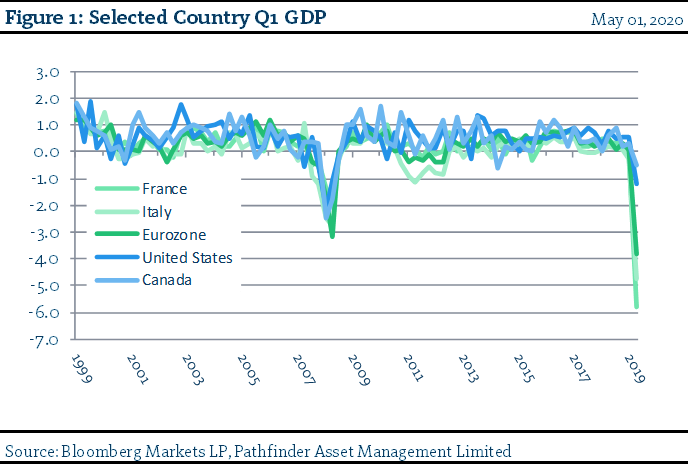Developed Market GDP
This week, we were able to get a preliminary picture of the economic impact of the pandemic from governments around the world with the release of Gross Domestic Product (GDP) data. GDP is an interesting measure but, by its nature, is backward looking and usually not a very good input in determining our view of the individual companies that we invest in. We would not normally spend much time in this note (or in our Investment Committee) discussing GDP, but because of the current situation and the quick change to the global economy, we thought it useful to discuss the reports this week.
Data was released for parts of Europe and North America. There seems to be a uniform split between different parts of the economy across all countries. Retail services and commercial investment have taken a serious hit during the shutdown, but goods consumption and residential investment has held up. This does make sense given the pattern of behavior change: we are buying groceries and staying home, instead of going to restaurants and traveling. The same for commercial and residential investment, people are still building and renovating houses, while businesses have stopped that type of activity.
- Figure 1 presents Gross Domestic Product data for select European countries, the United States and Canada. We had to do some adjustments to make the numbers comparable, as not all countries release their data the same way.

- The green lines are from Europe. They look a little worse because the pandemic started there earlier, so a larger portion of the quarter is representative of the effects of mitigation policies implemented by governments.
- The blue lines are Canada and the US. It appears that Canada looks very similar to the US at this point. That does make sense given our reliance on manufacturing for the US economy and our exposure to commodities, which have experienced significant impact. One item to note about the US is the drop in personal consumption. The consumer is approximately 70% of the US economy and its year-on-year growth is at a 40-year low, so this was, and will continue to be, a major driver.
“This means that” because Q1 represents only a partial impact of mitigation policies, we should expect Q2 to be worse. In our Investment Committee this week, we concluded that Q2 is already reflected in financial markets. The real question from an investment perspective is: What does Q3 look like? At this point, no one knows the answer to that question.
National Instrument 31-103 requires registered firms to disclose information that a reasonable investor would expect to know, including any material conflicts with the firm or its representatives. Doug Johnson and/or Pathfinder Asset Management Limited are an insider of companies periodically mentioned in this report. Please visit www.paml.ca for full disclosures.
*All returns are time weighted and net of investment management fees. Returns from the Pathfinder Partners’ Fund and Pathfinder Real Fund are presented based on the masters series of each fund. The Pathfinder North American Equity Portfolio and The Pathfinder North American Income Portfolio are live accounts. These are actual accounts owned by the Pathfinder Chairman (Equity) and client (High Income) which contain no legacy positions, cash flows or other Pathfinder investment mandates or products. Monthly inception dates for each fund and portfolio are as follows: Pathfinder North American Equity Portfolio (January 2011), Pathfinder North American High-Income Portfolio (October 2012) Pathfinder Partners’ Fund (April 2011), Pathfinder Real Fund (April, 2013), and Pathfinder International Fund (November 2014).
Pathfinder Asset Management Limited (PAML) and its affiliates may collectively beneficially own in excess of 10% of one or more classes of the issued and outstanding equity securities mentioned in this newsletter. This publication is intended only to convey information. It is not to be construed as an investment guide or as an offer or solicitation of an offer to buy or sell any of the securities mentioned in it. The author has taken all usual and reasonable precautions to determine that the information contained in this publication has been obtained from sources believed to be reliable and that the procedures used to summarize and analyze such information are based on approved practices and principles in the investment industry. However, the market forces underlying investment value are subject to sudden and dramatic changes and data availability varies from one moment to the next. Consequently, neither the author nor PAML can make any warranty as to the accuracy or completeness of information, analysis or views contained in this publication or their usefulness or suitability in any particular circumstance. You should not undertake any investment or portfolio assessment or other transaction on the basis of this publication, but should first consult your portfolio manager, who can assess all relevant particulars of any proposed investment or transaction. PAML and the author accept no liability of any kind whatsoever or any damages or losses incurred by you as a result of reliance upon or use of this publication.